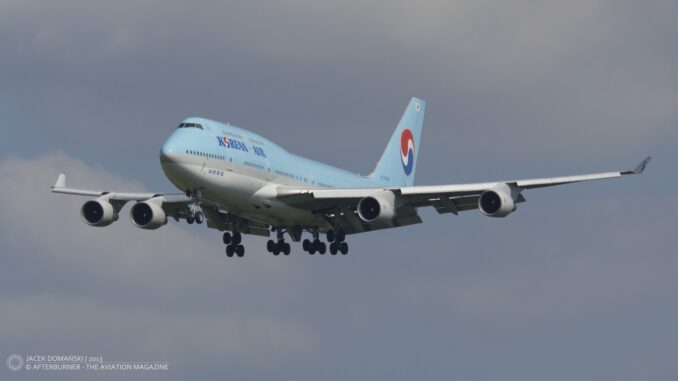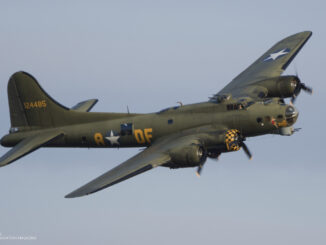
Boeing 747 enters the regular service, performing its first scheduled passenger flight with Pan Am airline, on the New York – London route.
Yes, it really has been more than a half of the century since the 747 appeared in the sky and revolutionized the passenger air transport. The Boeing´s airliner became the first wide-body, twin-aisle passenger aircraft, it was the first to have high ceiling and almost vertical sidewalls and, also for the first time, the passenger compartment was not designed in a shape of a long tube but divided for several smaller cabins. The unusual size and general appearance quickly earned the new airliner the nickname ´Jumbo Jet´ (sometimes abbreviated just to ´Jumbo´), while the airlines and media often referred to it as the ´Queen of the Sky´.
The new airliner quickly gained an immensely good reputation and become one of the airlines favourite aeroplane. Although the main idea behind creating an aircraft as huge as 747 was to reduce the operational cost per seat, this could be achieved only with the fully occupied airliner. Nevertheless, many carriers bought a 747 just for marketing purposes, without any economic reasons to operate such a big passenger aircraft – many times it was just a matter of an airline prestige to have a 747, not the economic viability.
Despite the huge interest in the new airliner, with almost two hundred 747s pre-ordered before the launch of its serial production, both Boeing and market analysts forecasted a short operational life of ´Jumbo Jet´. It was the era when first supersonic airliners – Tu-144 and Concorde – entered the operational service, the whole world was impressed by the new technology and almost everyone expected that the days of big, subsonic airliners are already counted.
And exactly those forecasts were the reason behind the characteristic silhouette of Boeing 747, with the raised cockpit and additional passenger compartment behind it. In case the supersonic airliners would take over the long-haul passenger flights, the 747 could easily be converted into a freight aircraft with a cargo nose door.
Nevertheless, the recession and oil crisis of 1970s have negatively verified the market forecasts. Supersonic airliners became just an interesting curiosity, passenger traffic dropped and the economic point of view prevailed over the prestige. It was also a hard time for Boeing and 747 sales – despite the promising introduction and initial sales, the numbers rapidly declined. There were only seven ´Jumbo Jets´ ordered in 1971 and sixteen per annum (on the average) in five following years. A few flag-airliners even decided to use their 747 only as freightliners or replaced them with smaller aircraft.
The situation slowly started to improve in 1980s and finally stabilized in 1990s. And exactly in the 1990 there were 122 orders for 747 placed, marking it as the record-year for Boeing. Until today, there were more than 1,500 ´Jumbo Jets´ manufactured, of all types and variants. Although the market has changed totally since the maiden flight of 747, this aircraft is still being manufactured today.
Obviously, nowadays it is a completely different aeroplane. Its current version – Boeing 747-8, was introduced in 2011 and now is offered in two variants: 747-8F (Freight) and 747-8I (Intercontinental, passenger airliner). The new ´Jumbo Jet´ is now being operated by eleven carriers, including UPS, Lufthansa, Korean Air and Air China.
During the fifty years of manufacturing there were several variants of 747 developed, including the 747SP shortened version, 747-400 with increased range, 747 LCF Dreamlifter to carry the sub-assemblies for Boeing 787, 747 Supertanker for fire-fighting, Shuttle Carrier Aircraft and – probably the most known one – VC-25 used as the USAF Air Force One and carrying the President of the United States.
Regrettably, although still being manufactured and ordered, the great days of ´Jumbo Jet´ are already over. Several airlines already withdrawn them from operational service, replacing the 747 with more economical two-engine jets. There were less than two hundred ´Jumbo Jets´ reported as operational last year, but – due to coronavirus outbreak – just a few of them were really in active service.
And the passenger traffic decrease caused by Covid-19 only accelerated the process of retiring the 747 airliners. British Airways (one of the largest ´Jumbo Jet´ operators in the world, with 33 aircraft of that type) is one of such examples – in July of 2020 the company announced the 747s would be withdrawn from service and the final flight was performed on 8th October.
Although the Boeing 747 will remain with us for a while, it hardly would have any significant impact on the airline traffic. It seems that the number of still operating passenger variants of ´Jumbo Jet´ would be continuously reduced. However, the increasing demand for cargo aircraft could be a second chance for 747 and the ´Queen of the Sky´ could survive for many years as the freight airliner.
Pictured above is Boeing 747-4B5 (registered HL7493) of Korean Air, Prague-Ruzyně, July 2013.



